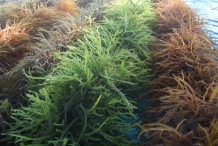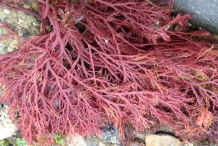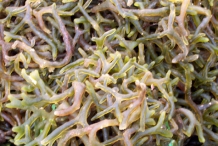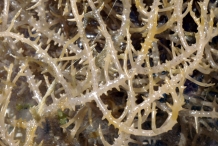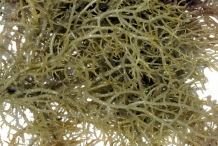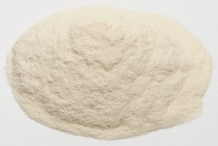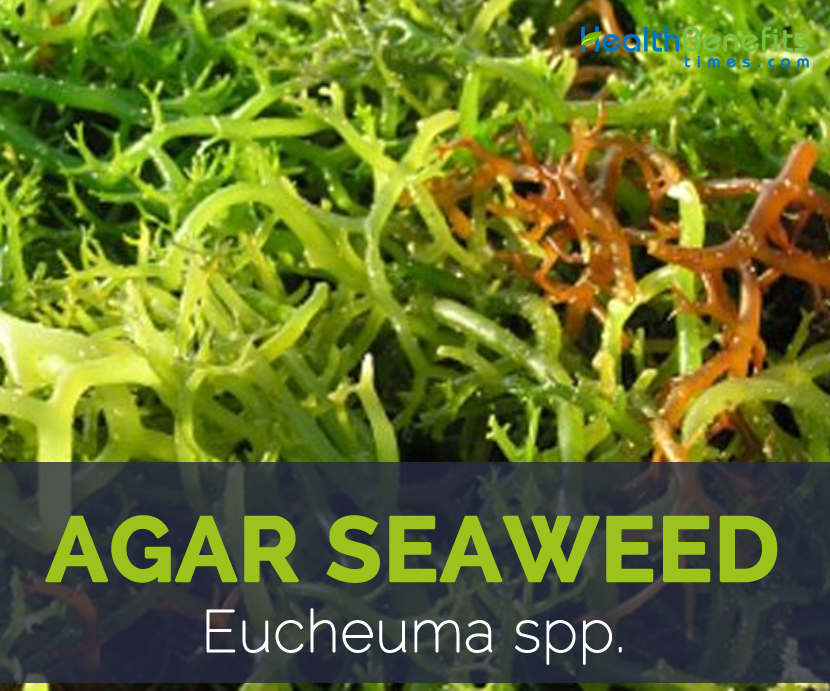 Agar seaweed scientifically known as Eucheuma spp. is seaweeds that are most common and fast growing species in the Philippines and are found from just below the low tide mark to the upper subtidal zone of the reef, growing usually on sandy-corally to rocky substrata where water movement is slow to moderate. They grow by means of an apical meristem consisting of a group of actively dividing cells at the tip of the branches. They exhibit a triphasic life cycle, consisting of the gametophyte (n) (dioecious), carposporophyte (2n) and the sporophyte (2n).
Agar seaweed scientifically known as Eucheuma spp. is seaweeds that are most common and fast growing species in the Philippines and are found from just below the low tide mark to the upper subtidal zone of the reef, growing usually on sandy-corally to rocky substrata where water movement is slow to moderate. They grow by means of an apical meristem consisting of a group of actively dividing cells at the tip of the branches. They exhibit a triphasic life cycle, consisting of the gametophyte (n) (dioecious), carposporophyte (2n) and the sporophyte (2n).
Even though commercially significant, species of eucheuma are difficult to identify without the aid of close scientific examination, as different species may have very similar morphologies. It is assumed that eighteen to twenty species alone fall within the genus Eucheuma, represented by the groups Cottoniformia, Eucheuma, Gelatiformia, and Anaxiferae.
The thallus of Eucheuma ranges from 35 to 74 cm. Branches are brittle to cartilaginous in consistency, ranging from 7 to 9 cm in length, with whorled/spinous branchlets. The cell diameters are as follows: 2-5 µm outer cortexes, 30-196 µm inner cortex and 20-45 µm medulla. Rhizoids of the medulla are present but thylles are absent. Tetrasporangia are zonate with tetraspores ranging from 13 to 36 µm in diameter. Spermatophyte conceptacles range over 350-650 x 300-420 µm with a spermatial diameter of 14-29 µm. Cystocarps and carpospores have not been observed in this species.
Nutritional value
Agar seaweed which is also known as Guso is seaweeds that are most common and fast growing species in the Philippines and consists of minimal amount of essential nutrients, minerals and vitamins that are essential in our daily life.
Serving Size: 1/8 Cup, 10 g
Calories 3 Kcal. Calories from Fat +++ Kcal.
| Proximity |
Amount |
% DV |
| Water |
9.13 g |
N/D |
| Energy |
3 Kcal |
N/D |
| Energy |
11 kJ |
N/D |
| Protein |
0.05 g |
0.10% |
| Total Fat (lipid) |
0 g |
0.00% |
| Ash |
0.14 g |
N/D |
| Carbohydrate |
0.68 g |
0.52% |
| Total dietary Fiber |
0 g |
0.00% |
| Total Sugars |
0.03 g |
N/D |
| Minerals |
Amount |
% DV |
| Calcium, Ca |
5 mg |
0.50% |
| Iron, Fe |
0.19 mg |
2.38% |
| Magnesium, Mg |
7 mg |
1.67% |
| Potassium, K |
23 mg |
0.49% |
| Sodium, Na |
1 mg |
0.07% |
| Zinc, Zn |
0.06 mg |
0.55% |
| Copper, Cu |
0.006 mg |
0.67% |
| Manganese, Mn |
0.037 mg |
1.61% |
| Selenium, Se |
0.1 µg |
0.18% |
| Vitamins |
Amount |
% DV |
| Water soluble Vitamins |
|
|
| Vitamin B2 (Riboflavin) |
0.002 mg |
0.15% |
| Vitamin B3 (Niacin) |
0.006 mg |
0.04% |
| Vitamin B5 (Pantothenic acid) |
0.03 mg |
0.60% |
| Vitamin B6 (Pyridoxine) |
0.003 mg |
0.23% |
| Vitamin B9 (Folate) |
8 µg |
2.00% |
| Folate, food |
8 µg |
N/D |
| Folate, DEF |
8 µg |
N/D |
| Choline |
0.6 mg |
0.11% |
| Fat soluble Vitamins |
|
N/D |
| Vitamin E (alpha-tocopherol) |
0.09 mg |
0.60% |
| Vitamin K (phylloquinone) |
0.2 µg |
0.17% |
| Lipids |
Amount |
% DV |
| Fatty acids, total saturated |
0.001 g |
N/D |
| Fatty acids, total polyunsaturated |
0.001 g |
N/D |
*Above mentioned Percent Daily Values (%DVs) are based on 2,000 calorie diet intake. Daily values (DVs) may be different depending upon your daily calorie needs. Mentioned values are recommended by a U.S. Department of Agriculture. They are not healthbenefitstimes.com recommendations. Calculations are based on average age of 19 to 50 years and weighs 194 lbs.
Calories 306 Kcal. Calories from Fat 2.7 Kcal.
| Proximity |
Amount |
% DV |
| Water |
8.68 g |
N/D |
| Energy |
306 Kcal |
N/D |
| Energy |
1282 kJ |
N/D |
| Protein |
6.21 g |
12.42% |
| Total Fat (lipid) |
0.3 g |
0.86% |
| Ash |
3.93 g |
N/D |
| Carbohydrate |
80.88 g |
62.22% |
| Total dietary Fiber |
7.7 g |
20.26% |
| Total Sugars |
2.97 g |
N/D |
| Minerals |
Amount |
% DV |
| Calcium, Ca |
625 mg |
62.50% |
| Iron, Fe |
21.4 mg |
267.50% |
| Magnesium, Mg |
770 mg |
183.33% |
| Phosphorus, P |
52 mg |
7.43% |
| Potassium, K |
1125 mg |
23.94% |
| Sodium, Na |
102 mg |
6.80% |
| Zinc, Zn |
5.8 mg |
52.73% |
| Copper, Cu |
0.61 mg |
67.78% |
| Manganese, Mn |
4.3 mg |
186.96% |
| Selenium, Se |
7.4 µg |
13.45% |
| Vitamins |
Amount |
% DV |
| Water soluble Vitamins |
|
|
| Vitamin B1 (Thiamin) |
0.01 mg |
0.83% |
| Vitamin B2 (Riboflavin) |
0.222 mg |
17.08% |
| Vitamin B3 (Niacin) |
0.202 mg |
1.26% |
| Vitamin B5 (Pantothenic acid) |
3.018 mg |
60.36% |
| Vitamin B6 (Pyridoxine) |
0.303 mg |
23.31% |
| Vitamin B9 (Folate) |
580 µg |
145.00% |
| Folate, food |
580 µg |
N/D |
| Folate, DEF |
580 µg |
N/D |
| Choline |
63.3 mg |
11.51% |
| Fat soluble Vitamins |
|
|
| Vitamin E (alpha-tocopherol) |
5 mg |
33.33% |
| Vitamin K (phylloquinone) |
24.4 µg |
20.33% |
| Lipids |
Amount |
% DV |
| Fatty acids, total saturated |
0.061 g |
N/D |
| Myristic acid 14:00(Tetradecanoic acid) |
0.003 g |
N/D |
| Palmitic acid 16:00 (Hexadecanoic acid) |
0.055 g |
N/D |
| Stearic acid 18:00 (Octadecanoic acid) |
0.003 g |
N/D |
| Fatty acids, total monounsaturated |
0.027 g |
N/D |
| Palmitoleic acid 16:1 (hexadecenoic acid) |
0.009 g |
N/D |
| Oleic acid 18:1 (octadecenoic acid) |
0.009 g |
N/D |
| Gadoleic acid 20:1 (eicosenoic acid) |
0.009 g |
N/D |
| Fatty acids, total polyunsaturated |
0.102 g |
N/D |
| Linoleic acid 18:2 (octadecadienoic acid) |
0.004 g |
N/D |
| Linolenic acid 18:3 (Octadecatrienoic acid) |
0.001 g |
N/D |
| Arachidonic acid 20:4 (Eicosatetraenoic acid) |
0.01 g |
N/D |
*Above mentioned Percent Daily Values (%DVs) are based on 2,000 calorie diet intake. Daily values (DVs) may be different depending upon your daily calorie needs. Mentioned values are recommended by a U.S. Department of Agriculture. They are not healthbenefitstimes.com recommendations. Calculations are based on average age of 19 to 50 years and weighs 194 lbs.
Comments
comments
 Agar seaweed scientifically known as Eucheuma spp. is seaweeds that are most common and fast growing species in the Philippines and are found from just below the low tide mark to the upper subtidal zone of the reef, growing usually on sandy-corally to rocky substrata where water movement is slow to moderate. They grow by means of an apical meristem consisting of a group of actively dividing cells at the tip of the branches. They exhibit a triphasic life cycle, consisting of the gametophyte (n) (dioecious), carposporophyte (2n) and the sporophyte (2n).
Agar seaweed scientifically known as Eucheuma spp. is seaweeds that are most common and fast growing species in the Philippines and are found from just below the low tide mark to the upper subtidal zone of the reef, growing usually on sandy-corally to rocky substrata where water movement is slow to moderate. They grow by means of an apical meristem consisting of a group of actively dividing cells at the tip of the branches. They exhibit a triphasic life cycle, consisting of the gametophyte (n) (dioecious), carposporophyte (2n) and the sporophyte (2n).

